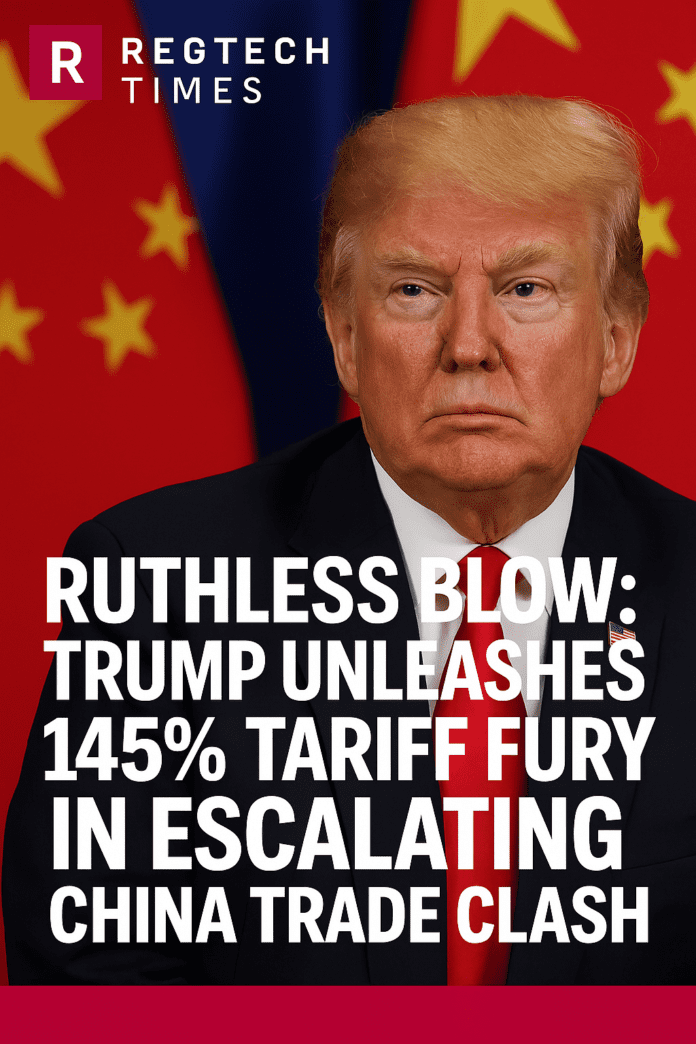The United States has taken a bold and dramatic step in its ongoing trade conflict with China. President Trump has increased tariffs on Chinese goods to a staggering 145%, the highest level seen in years. This means that most products coming from China into the U.S. will now be much more expensive due to this new tax at the border.
These new tariffs build on earlier ones. Earlier this year, a 20% tariff was already placed on Chinese imports. Then, on Wednesday, Trump added another 125% tariff, which raised the total to 145%. At first, people thought it was just 125%, but the White House later confirmed it includes the previous 20%.
The White House said the decision was part of a plan to pressure China over its role in the global fentanyl crisis and to correct what the U.S. sees as unfair trade practices. The move came just one day after Trump paused tariff increases on dozens of other countries for 90 days, suggesting that the White House is targeting China more aggressively than others.
China’s 84% Tariffs Mark New Chapter In US Trade War
While speaking about this decision, U.S. officials said they want the world to treat the U.S. fairly and hinted that countries who don’t retaliate could see better treatment in the future. But this sharp increase has already rattled global markets and created uncertainty in economies across the world.
China Fights Back With Its Own Tariffs
China didn’t stay quiet. In response to the massive 145% tariffs from the U.S., China fired back with its own tariffs, increasing taxes on American products to 84%. These new Chinese tariffs came into effect on Thursday.
China’s leaders made it clear that they won’t be pushed around. They said they are ready to fight a full trade war and won’t enter talks just to please the U.S. China has already started reaching out to other countries in Europe and Asia. They hope to build stronger partnerships with them to reduce their reliance on trade with the U.S.
China’s top leaders have spoken with European Union leaders and the Association of Southeast Asian Nations to discuss trade and cooperation. China says it’s ready for any challenge and will introduce new policies to deal with the current uncertainty.
The Chinese government believes that by working with other countries, it can ease the pressure coming from the U.S. tariffs. But so far, not all countries are eager to side with China, especially while the U.S. remains a strong global power.
Markets Go Wild Amid Mixed Messages
The news of high tariffs shocked financial markets around the world. Stock markets saw big changes, with prices rising and falling quickly.
Trump Slaps 104% Tariffs on China in Big Trade Fight
After Trump announced he was pausing new tariffs on some countries, the U.S. stock market had its best day since 2008. The S&P 500 jumped 9.5% in a single day, and European markets also surged. Experts called this sudden change the “Trump Blink,” saying it looked like the U.S. was trying to calm markets while still hitting China hard.
But the calm didn’t last. The next day, as the full scale of the China tariffs became clear, markets dropped again. The S&P 500 fell by more than 3%, and investors rushed to buy gold, which rose nearly 3% to a record high. The U.S. dollar also dropped sharply against the Swiss franc.
In Asia, the Hong Kong Hang Seng Index took a big hit earlier in the week, falling 13%, the worst decline since 1997. Experts say the rapid changes are making markets extremely unstable and hard to predict.
Meanwhile, even though U.S. consumer prices dropped in March, which is usually good news, it wasn’t enough to calm fears. Investors are now watching closely as major American companies begin reporting their profits.
These latest events mark a serious deepening of the trade war between the two largest economies in the world. With both sides digging in and raising tariffs, the conflict is far from cooling down.


